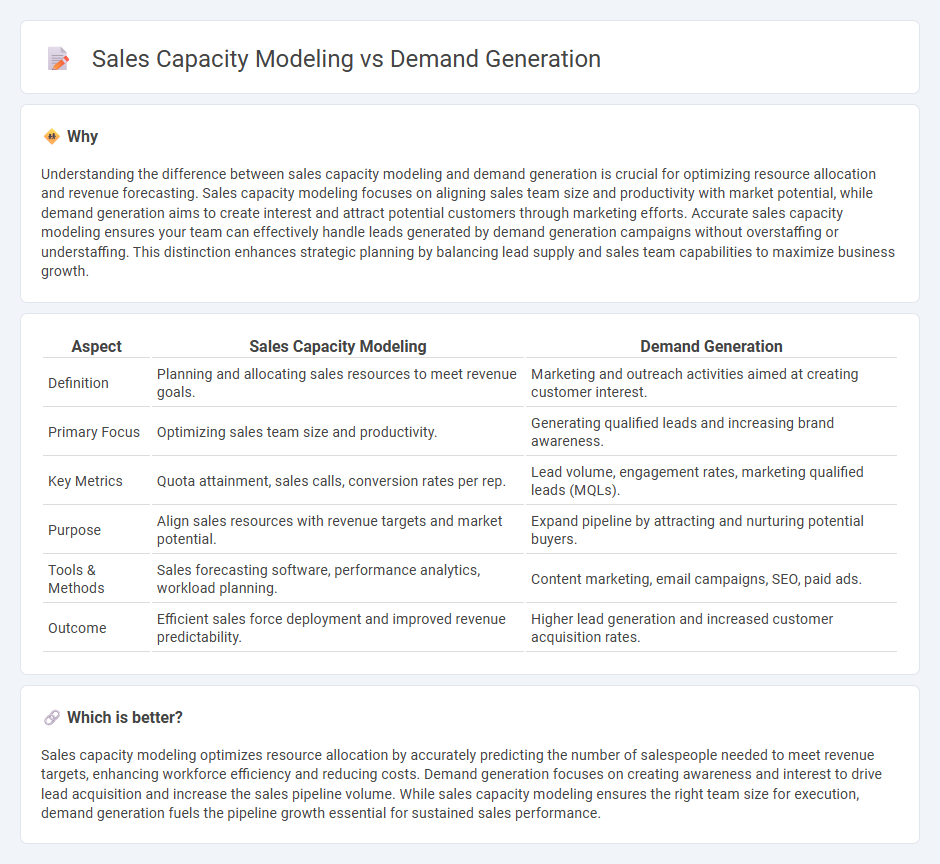
Sales capacity modeling predicts the optimal number of sales reps needed to achieve revenue targets by analyzing historical performance, market potential, and sales cycle length. Demand generation focuses on creating awareness and interest through marketing strategies to drive qualified leads into the sales funnel. Explore detailed strategies to align sales capacity with demand generation for maximizing growth.
Why it is important
Understanding the difference between sales capacity modeling and demand generation is crucial for optimizing resource allocation and revenue forecasting. Sales capacity modeling focuses on aligning sales team size and productivity with market potential, while demand generation aims to create interest and attract potential customers through marketing efforts. Accurate sales capacity modeling ensures your team can effectively handle leads generated by demand generation campaigns without overstaffing or understaffing. This distinction enhances strategic planning by balancing lead supply and sales team capabilities to maximize business growth.
Comparison Table
| Aspect | Sales Capacity Modeling | Demand Generation |
|---|---|---|
| Definition | Planning and allocating sales resources to meet revenue goals. | Marketing and outreach activities aimed at creating customer interest. |
| Primary Focus | Optimizing sales team size and productivity. | Generating qualified leads and increasing brand awareness. |
| Key Metrics | Quota attainment, sales calls, conversion rates per rep. | Lead volume, engagement rates, marketing qualified leads (MQLs). |
| Purpose | Align sales resources with revenue targets and market potential. | Expand pipeline by attracting and nurturing potential buyers. |
| Tools & Methods | Sales forecasting software, performance analytics, workload planning. | Content marketing, email campaigns, SEO, paid ads. |
| Outcome | Efficient sales force deployment and improved revenue predictability. | Higher lead generation and increased customer acquisition rates. |
Which is better?
Sales capacity modeling optimizes resource allocation by accurately predicting the number of salespeople needed to meet revenue targets, enhancing workforce efficiency and reducing costs. Demand generation focuses on creating awareness and interest to drive lead acquisition and increase the sales pipeline volume. While sales capacity modeling ensures the right team size for execution, demand generation fuels the pipeline growth essential for sustained sales performance.
Connection
Sales capacity modeling aligns the available sales resources with forecasted demand to maximize revenue opportunities. Demand generation activities create a pipeline of qualified prospects, directly influencing the volume and quality of leads that sales teams must handle. Effective integration of these processes ensures optimal allocation of sales personnel and improved conversion rates, driving sustainable business growth.
Key Terms
Lead Generation
Demand generation drives targeted lead generation by creating strategic marketing campaigns that attract and engage potential customers, significantly increasing qualified leads. Sales capacity modeling allocates resources effectively by analyzing historical sales data, forecasting future demand, and optimizing team size to meet lead conversion goals. Explore detailed strategies to enhance lead generation through integrated demand generation and sales capacity modeling approaches.
Pipeline Forecasting
Demand generation drives lead acquisition by targeting ideal customer profiles and increasing market engagement, directly influencing the volume of qualified prospects entering the sales funnel. Sales capacity modeling assesses the team's ability to handle pipeline activities by aligning headcount, skill sets, and productivity to forecast potential revenue outcomes accurately. Explore advanced pipeline forecasting techniques to enhance alignment between demand generation efforts and sales capacity for optimized revenue growth.
Resource Allocation
Demand generation drives qualified leads through targeted marketing campaigns, optimizing outreach to potential customers and increasing pipeline velocity. Sales capacity modeling assesses the optimal number of sales reps needed to manage leads effectively, balancing workload and maximizing conversion rates. Explore how integrating both strategies enhances resource allocation for sustainable revenue growth.
Source and External Links
What is Demand Generation? Definition, Strategies, Benefits - Demand generation is a B2B marketing and sales process aimed at increasing awareness and interest in a product or service by addressing prospects' problems and providing solutions, with the goal of generating high-quality leads through aligned marketing and sales efforts.
Demand generation - Wikipedia - Demand generation is a holistic marketing strategy that creates awareness and cultivates interest to drive sales, involving activities like awareness building, nurturing, and supporting customer evaluation, commonly used in B2B and complex sales cycles.
The Demand Generation Marketing Guide - Demand generation encompasses all marketing activities driving awareness and interest to create a predictable sales pipeline, focusing on nurturing prospects through multiple touchpoints to ultimately increase conversion rates and closed deals.
 dowidth.com
dowidth.com